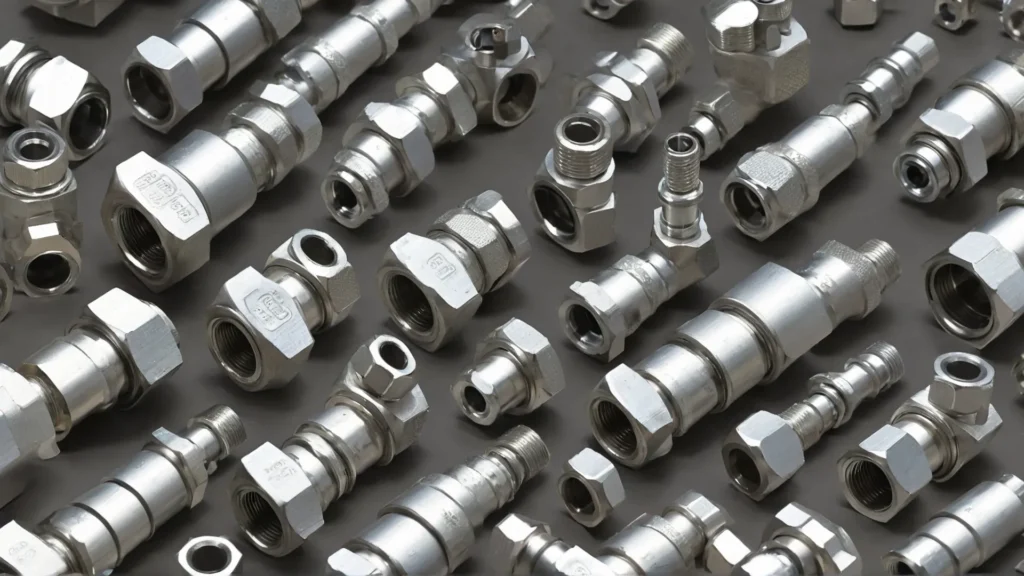How to Select the Right Hydraulic Fittings and Couplers
Hydraulic fittings and couplers play a vital role in connecting hoses, pipes, and tubes within hydraulic systems. Choosing the correct components not only enhances system performance but also prevents leaks and potential system failures.
This article will provide an in-depth look at how to select the right fittings and couplers for your hydraulic applications.
Understanding Hydraulic Fittings and Couplers
- Hydraulic Fittings: These are components used to connect different sections of a hydraulic system, such as hoses or tubes, ensuring a secure and leak-free connection. They come in various shapes and sizes to accommodate different system requirements.
- Hydraulic Couplers: These are devices that allow for quick connection and disconnection of fluid lines without significant fluid loss or contamination. They are essential for systems that require frequent assembly and disassembly.
Compatibility between fittings and couplers is crucial to prevent leaks and ensure efficient operation.
Types of Hydraulic Fittings
JIC (Joint Industry Council) Fittings
- Description: Known for their versatility, JIC fittings feature a 37-degree flare seating surface.
- Applications: Commonly used in fuel delivery and fluid power applications.
- Pros: High-pressure capability, reusable.
- Cons: Requires precise installation to avoid leaks.
O-ring Face Seal Fittings
- Description: Designed with an O-ring in the face that provides a leak-proof seal.
- Applications: Ideal for high-pressure applications.
- Pros: Excellent sealing capabilities, easy to assemble.
- Cons: O-rings may degrade over time with exposure to certain chemicals.
NPT (National Pipe Tapered) Fittings
- Description: Tapered threads create a seal by wedging into the female fitting.
- Applications: Widely used in North America.
- Pros: Simple design, widely available.
- Cons: May require sealant or tape to ensure a leak-free connection.
BSP (British Standard Pipe) Fittings
- Description: Similar to NPT but with different thread angles and pitches.
- Applications: Commonly used in Europe and Asia.
- Pros: Reliable sealing with proper installation.
- Cons: Not interchangeable with NPT without adapters.

Types of Hydraulic Couplers
Quick Disconnect Couplers
- Description: Allow for easy connection/disconnection without tools.
- Applications: Used where frequent hose changes are necessary.
- Pros: Time-saving, reduces downtime.
- Cons: May be less secure than threaded options under high pressure.
Flat Face Couplers
- Description: Designed to minimize fluid loss during disconnection.
- Applications: Ideal for environments where cleanliness is crucial.
- Pros: Reduces spillage, easy to clean.
- Cons: Can be more expensive than other types.
Threaded Couplers
- Description: Provide a secure connection through threaded engagement.
- Applications: Used in high-pressure applications where security is paramount.
- Pros: Strong connection, reliable under high pressure.
- Cons: Slower to connect/disconnect compared to quick disconnects.
Factors to Consider When Selecting Fittings and Couplers
- Pressure Rating: Ensure that the components can withstand the maximum pressure of your hydraulic system. Using fittings or couplers with inadequate pressure ratings can lead to failures or safety hazards.
- Size Compatibility: The size of the fittings and couplers must match the hoses or tubes they are connecting. Incorrect sizing can cause leaks or restrict fluid flow.
- Material Compatibility: Choose materials that resist corrosion and wear based on the fluids used in your system. Common materials include stainless steel, brass, and carbon steel.
- Environmental Conditions: Consider factors such as temperature extremes, humidity, and exposure to chemicals when selecting materials for your fittings and couplers.
FAQs
1.What is the difference between JIC and NPT fittings?
JIC fittings have a 37-degree flare seating surface and are known for their versatility, while NPT fittings use tapered threads to create a seal and are commonly used in North America.
2.How do quick disconnect couplers benefit hydraulic systems?
Quick disconnect couplers allow for easy connection and disconnection without tools, reducing downtime and making maintenance more efficient.
3.What should be considered regarding pressure ratings for hydraulic components?
It’s essential to ensure that the pressure rating of fittings and couplers matches or exceeds the maximum pressure of the hydraulic system to prevent failures or safety hazards.
Conclusion
Selecting the right hydraulic fittings and couplers requires careful consideration of various factors including type, size, material compatibility, and environmental conditions. Consulting with experts or manufacturers can provide additional insights tailored to your specific needs.





